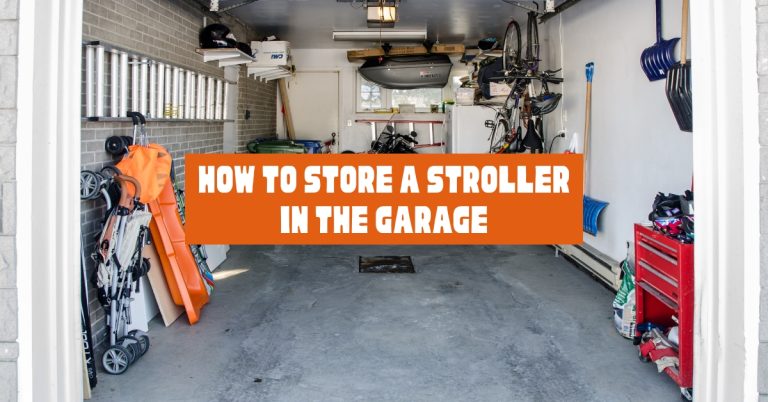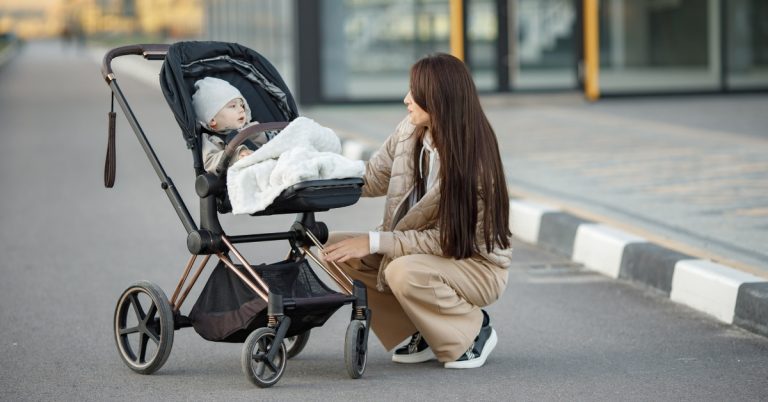As an Amazon Associate, I earn from qualifying purchases.
Every parent knows the feeling of watching their precious cargo roll away in a stroller, whether it’s down a gentle slope or into a busy street. Stroller security isn’t just about preventing theft—it’s about protecting your child, your investment, and your peace of mind. From bustling shopping centers to quiet neighborhood parks, knowing how to properly secure your stroller can mean the difference between a pleasant outing and a dangerous situation.
This comprehensive guide will walk you through everything you need to know about stroller security. You’ll learn practical steps to keep your stroller safe at home and on the go, discover the best places to store or lock your stroller, and master essential stroller safety tips that every parent should know. Whether you’re dealing with a lightweight umbrella stroller or a heavy-duty all-terrain model, these strategies will help you navigate parenthood with confidence.
Contents
Why Securing Your Stroller Matters
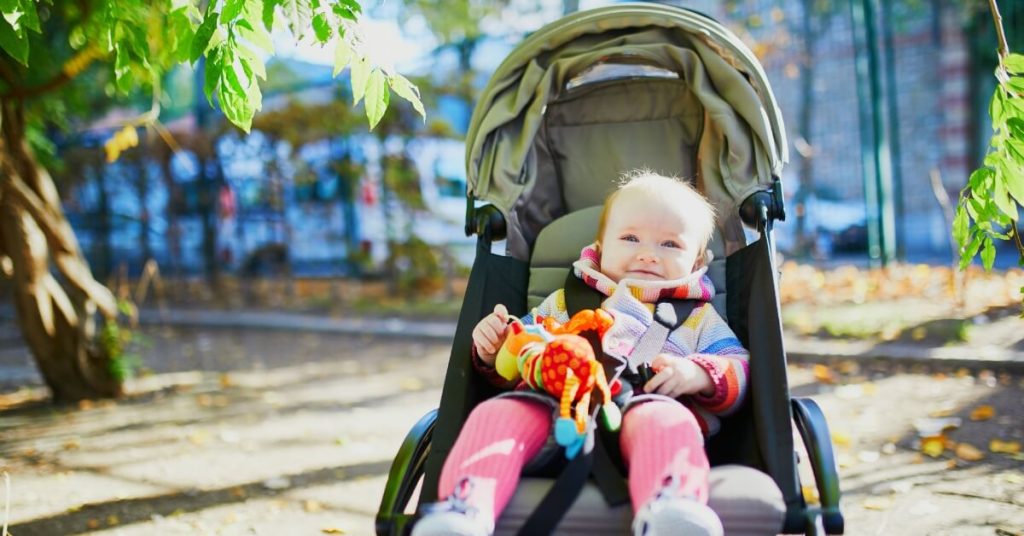
A stroller isn’t just a mode of transportation for your baby—it’s a critical part of their safety and comfort. Whether you’re at home, in a park, or traveling, securing your stroller properly can prevent accidents, theft, and unnecessary damage. This section will explain why stroller security is so important and how it benefits both you and your child.
Child Safety Comes First
The most important reason to secure your stroller properly is your child’s safety. An unsecured stroller can roll away unexpectedly, especially on inclined surfaces. Even a slight slope that seems harmless can cause a stroller to gain momentum quickly. When the brakes aren’t engaged or the stroller isn’t properly positioned, your child could end up in traffic, down stairs, or into obstacles.
Proper harness use is equally critical. Many parents underestimate how quickly children can wiggle out of loose straps or climb out of an improperly secured stroller. A securely fastened five-point harness system keeps your child safely contained, even during sudden stops or bumpy terrain.
Preventing Theft and Loss
Stroller theft is more common than many parents realize. High-end strollers can cost several hundred dollars, making them attractive targets for thieves. Popular locations for stroller theft include shopping malls, parks, restaurants, and tourist attractions. Even if you’re just stepping into a store for a few minutes, an unattended stroller can disappear quickly.
Beyond outright theft, strollers can also be accidentally taken by other parents in crowded areas, especially if you have a common model. Having a security system in place helps ensure your stroller stays where you left it.
Protecting Your Investment
Quality strollers represent a significant financial investment. Proper security measures don’t just prevent theft—they also protect your stroller from damage. Wind can knock over unsecured strollers, causing scratches, bent wheels, or broken components. Securing your stroller properly helps maintain its condition and extends its useful life.
Peace of Mind
When you know your stroller is secure, you can focus on enjoying time with your child rather than worrying about potential problems. This peace of mind is invaluable, especially during busy outings or when navigating unfamiliar areas.
How to Secure a Stroller: Step-by-Step Guide
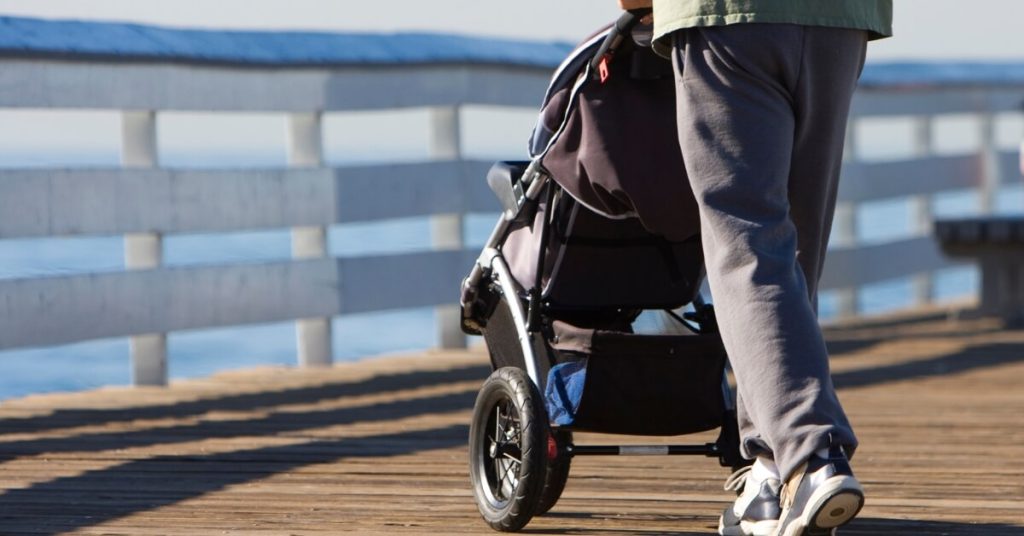
Securing your stroller the right way doesn’t have to be complicated. With a few simple and practical steps, you can keep your stroller safe whether you’re at home or on the go.
Step 1: Always Engage the Stroller Brakes
The brake system is your first line of defense against runaway strollers. Every time you stop, even for a moment, engage the brakes on both rear wheels. This simple habit can prevent accidents on slopes, in parking lots, or anywhere your stroller might roll.
Most strollers have either foot-operated brakes or hand brakes. Foot brakes typically involve stepping down on a lever or bar between the rear wheels. Hand brakes work similarly to bicycle brakes and are common on jogging strollers. Test your brakes regularly to ensure they’re working properly, and clean them if they become clogged with dirt or debris.
Step 2: Use Stroller Safety Harnesses Correctly
A proper harness system keeps your child secure while allowing comfortable movement. Most modern strollers come with five-point harness systems that secure your child at the shoulders, waist, and between the legs. Always ensure the harness fits snugly but comfortably—you should be able to fit two fingers between the straps and your child’s body.
Check the harness regularly for wear and tear. Frayed straps, broken buckles, or worn padding should be replaced immediately. Adjust the harness as your child grows, and never use a stroller without engaging the harness system, even for short trips.
Step 3: Secure the Stroller with a Lock When Outdoors
When leaving your stroller unattended in public spaces, use a reliable locking system. Cable locks work well for most situations and can secure your stroller to bike racks, fences, or designated stroller parking areas. Look for locks with weather-resistant materials and combinations or keys that you can easily remember or access.
Some parents prefer small padlocks that can secure the stroller’s folding mechanism, making it difficult for thieves to collapse and carry away the stroller. Others use wheel locks that prevent the stroller from rolling, though these don’t prevent theft as effectively as cable locks.
Step 4: Fold and Store Indoors When Not in Use
Whenever possible, bring your stroller inside when you’re not using it. Outdoor storage exposes your stroller to weather, theft, and damage. If you must store your stroller outside, use a covered area like a porch or garage, and consider using a stroller cover to protect it from the elements.
Indoor storage also allows you to perform regular maintenance checks, clean the stroller, and ensure all components are working properly. Create a designated storage area that’s easily accessible but out of the way of daily activities.
Step 5: Consider Anti-Theft Alarms or GPS Trackers
For high-value strollers or high-risk areas, consider investing in additional security measures. Motion-activated alarms can alert you if someone moves your stroller, while GPS trackers can help you locate a stolen stroller. These devices are becoming more affordable and user-friendly, with many offering smartphone apps for easy monitoring.
Some modern strollers come with built-in security features, while aftermarket options can be added to existing strollers. Research compatibility with your stroller model before purchasing any electronic security devices.
Best Places and Ways to Lock or Store a Stroller Safely
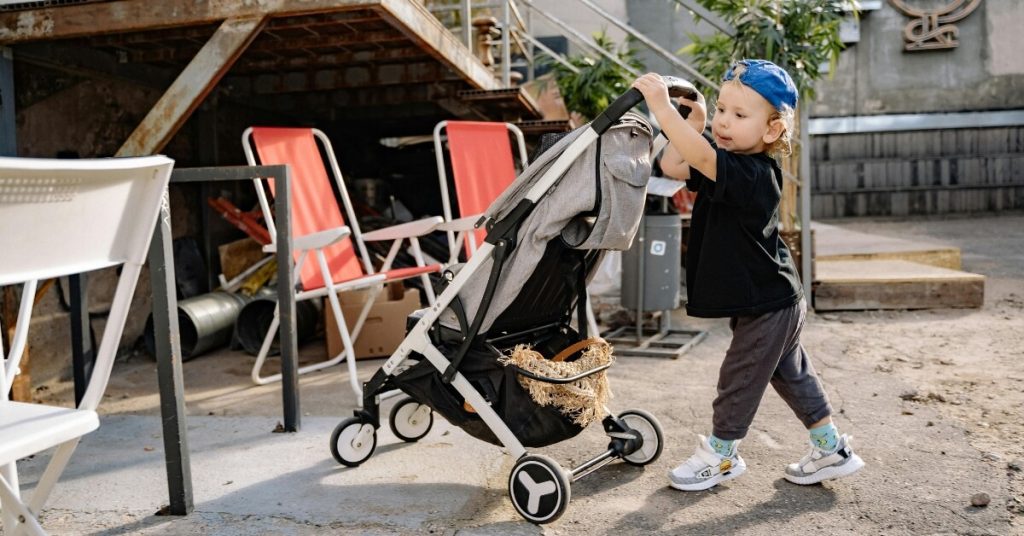
Where and how you store your stroller plays a big role in its safety and longevity. Whether it’s at home, in your car, or in public, choosing the right spot and using the right tools can protect your stroller from damage, theft, or unnecessary wear.
Secure Home Storage Solutions
At home, your stroller should be stored in a safe, dry location that’s easily accessible when needed. Entryways work well for families who use their strollers daily, but ensure the stroller doesn’t block emergency exits or create tripping hazards. Install wall hooks or brackets designed for stroller storage to keep the stroller off the floor and out of the way.
Garages provide excellent storage space, especially for larger strollers or multiple strollers. Use wall-mounted storage systems or ceiling hooks to maximize space. If your garage isn’t climate-controlled, consider using a stroller cover to protect against dust and moisture.
Closets can work for compact strollers, but ensure adequate ventilation to prevent mold or mildew. Basement storage is possible but requires careful attention to humidity levels and pest control.
Public Space Security Strategies
When using your stroller in public spaces, look for designated stroller parking areas. Many malls, restaurants, and attractions now provide these spaces, which are often monitored and designed with security in mind. These areas typically feature bike rack-style barriers that work well with cable locks.
If designated stroller parking isn’t available, look for sturdy, immovable objects to secure your stroller to. Bike racks, fence posts, and structural elements of buildings can work well. Avoid securing your stroller to temporary fixtures, vehicles, or objects that could be moved easily.
Position your stroller in well-lit, visible areas where foot traffic is moderate. Areas that are too isolated invite theft, while extremely busy areas may result in accidental damage or displacement.
Vehicle Storage and Transport
When transporting your stroller in a vehicle, proper securing prevents damage and ensures safety. Many strollers can be partially disassembled for easier transport—remove wheels, fold the frame, and secure loose parts to prevent rattling or shifting.
Use cargo nets, bungee cords, or tie-down straps to secure the stroller in your vehicle. This prevents the stroller from becoming a projectile during sudden stops or accidents. Never place unsecured strollers in areas where they could interfere with vehicle operation or passenger safety.
For families who frequently travel with strollers, consider a roof rack or hitch-mounted carrier designed for stroller transport. These systems keep the stroller secure while freeing up interior space for passengers and other cargo.
Stroller Safety Tips for Walking and Traveling
Walking or traveling with a stroller involves more than just pushing it along. Staying alert on slopes, securing loose items, and avoiding heavy bags on the handle can prevent tipping and keep your child safe during any journey.
Maintaining Control on Slopes and Inclines
Slopes present unique challenges for stroller safety. Always maintain a firm grip on the stroller handle, and position yourself uphill from the stroller when possible. This positioning allows you to catch the stroller if it begins to roll and provides better leverage for control.
When walking downhill, slow your pace and use the stroller’s brakes intermittently to control speed. Many jogging strollers have hand brakes that allow for gradual speed control, while standard strollers may require more careful positioning and pace management.
Avoid taking strollers on slopes that are too steep for safe navigation. When in doubt, look for alternative routes or carry your child up or down challenging inclines.
Proper Loading and Weight Distribution
Hanging heavy bags on stroller handles creates a tipping hazard that can cause the stroller to fall backward. This is especially dangerous when your child isn’t in the stroller, as the weight distribution becomes unstable. Use the stroller’s storage basket or attach bags to the frame rather than the handles.
Most strollers have weight limits for both the child and cargo areas. Exceeding these limits can cause structural damage and create safety hazards. Check your stroller’s manual for specific weight restrictions and stick to them.
Distribute weight evenly in the storage basket, and avoid placing heavy items on one side of the stroller. Uneven weight distribution can cause the stroller to pull to one side or tip over during turns.
In crowded areas, consider using a wrist strap attached to your stroller. This provides an additional connection point and can prevent the stroller from getting away from you in busy spaces. Many parents find wrist straps particularly useful in airports, train stations, and busy shopping areas.
When using public transportation, familiarize yourself with the system’s stroller policies. Some buses and trains have designated stroller areas, while others may require you to fold your stroller during transport. Plan your route accordingly and allow extra time for boarding and disembarking.
In elevators, always face the stroller toward the door you’ll exit from, and keep your hand on the stroller at all times. This prevents the stroller from rolling if the elevator stops suddenly or if the floor is slightly uneven.
Weather Considerations
Weather conditions can significantly affect stroller safety. Wet surfaces increase the risk of slipping and reduce brake effectiveness. In rainy conditions, dry your stroller’s brakes before relying on them, and be extra cautious on smooth surfaces like tile or painted concrete.
Wind can catch stroller canopies and cause instability. In windy conditions, consider removing or folding the canopy, and be prepared for gusts that might affect your control of the stroller.
Snow and ice create obvious hazards for stroller navigation. Consider using a stroller with larger wheels or winter-specific tires if you frequently encounter these conditions. Always clear snow and ice from the stroller’s brakes and wheels before use.
Final Verdict
Developing consistent stroller safety habits takes time but pays dividends in preventing accidents and theft. Start by creating a mental checklist that you run through every time you use your stroller: check the brakes, secure the harness, assess the environment, and plan your securing strategy.
Teach older children about stroller safety, including why they need to stay harnessed and how they can help keep the stroller secure. Children who understand the importance of stroller safety are more likely to cooperate with security measures.
Regularly inspect your stroller for wear and tear, paying special attention to brake systems, harness components, and wheel integrity. Address any maintenance issues immediately, as small problems can quickly become safety hazards.
Stay informed about stroller recalls and safety updates from manufacturers. Register your stroller with the manufacturer to receive important safety notices, and keep your stroller’s manual in an easily accessible location.
Frequently Asked Questions
Can I lock my stroller outside a store?
Yes, you can lock your stroller outside a store, but choose your location carefully. Look for designated stroller parking areas or secure bike racks in well-lit, visible locations. Use a quality cable lock and remove any valuable items from the stroller before going inside. However, if possible, bringing a compact stroller inside is always the safest option.
What type of stroller lock is best for travel?
For travel, a lightweight cable lock with a combination mechanism works best. These locks are TSA-friendly, don’t require you to keep track of keys, and can secure your stroller to various fixed objects. Look for locks with weather-resistant coatings and cables long enough to accommodate different securing points.
How do I keep my stroller from rolling away on slopes?
Always engage both rear wheel brakes when stopping on any slope, no matter how gentle it appears. Position yourself uphill from the stroller when possible, and maintain a firm grip on the handle. For steep slopes, consider carrying your child instead of using the stroller, or look for alternative routes with gentler inclines.
Is it safe to leave my stroller in the car?
Leaving your stroller in your car is generally safe from theft, but be aware of temperature considerations. Hot cars can damage stroller components, especially plastic parts and padding. If you must leave your stroller in the car during hot weather, use sunshades and try to park in shaded areas. Secure the stroller to prevent it from moving during transport.
How do I prevent my stroller from being stolen at theme parks?
Theme parks present unique security challenges due to their size and crowds. Use designated stroller parking areas when available, and consider using a brightly colored stroller cover or unique decorations to make your stroller easily identifiable. Take a photo of your stroller’s location and nearby landmarks. Some families use GPS trackers for expensive strollers when visiting large attractions.
As an Amazon Associate, I earn from qualifying purchases.

